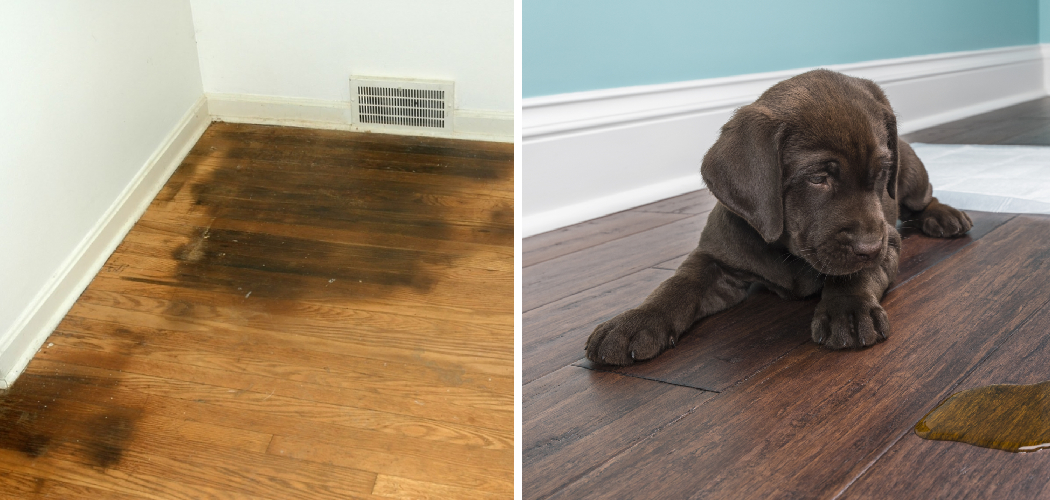Dogs are often regarded as a man’s best friend – for good reason. They provide us with love, companionship, and endless entertainment. Unfortunately, they also come with their fair share of messes, including urine stains on wooden floors.
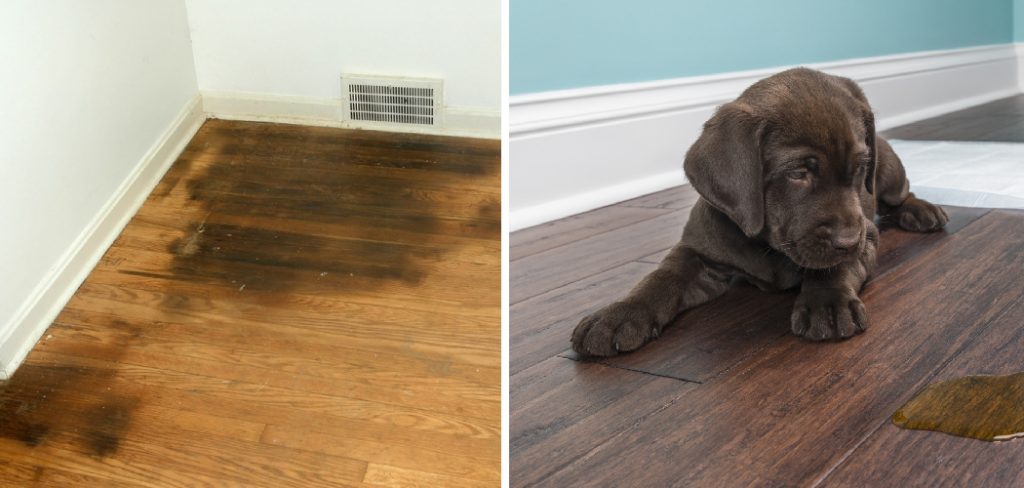
Not to worry, though – this guide will provide you with all the information you need to successfully treat dog urine on wood floors and prevent further damage. So keep reading to learn more about how to treat dog urine on wood floors.
Can You Treat Dog Urine on Wood Floors?
If you’re a pet owner, experiencing some accidents on your hardwood floors is inevitable. While cleaning up urine on tile or carpet is easy, things can get tricky when dealing with wood flooring. However, you can always treat dog urine on wood floors! The first thing to do is to clean up the mess as soon as possible, as the longer the urine sits on the floor, the more damage it can cause.
Use a paper towel or a clean cloth to blot up as much urine as possible, and rinse the area with warm water. After that, you can use specialized pet urine odor and stain removers or make a DIY solution to help eliminate the smell and prevent any long-term damage.
Regardless of your choice, acting fast before the urine can penetrate the wood and cause more substantial damage is important. With the right approach, you can easily treat dog urine on wood floors and keep your home smelling and looking fresh and clean.
Why Should You Treat Dog Urine on Wood Floors?
Wooden floors bring a classic and elegant look to any room in your home, but your furry friend’s urine can easily damage them. Dog urine contains acidic properties that can penetrate the wood, causing it to discolor, warp, and even smell. Treating dog urine on wood floors is essential not only to maintain the beauty and lifespan of your flooring but also for the health of your dog and family.
Unattended urine can potentially attract bacteria and cause infections. Moreover, the pungent odor can be overwhelming, making spending time in the room unpleasant. With effective cleaning methods, such as using white vinegar and baking soda, or specially formulated cleaners, you can remove urine stains and deodorize your floors, leaving them looking new and fresh.
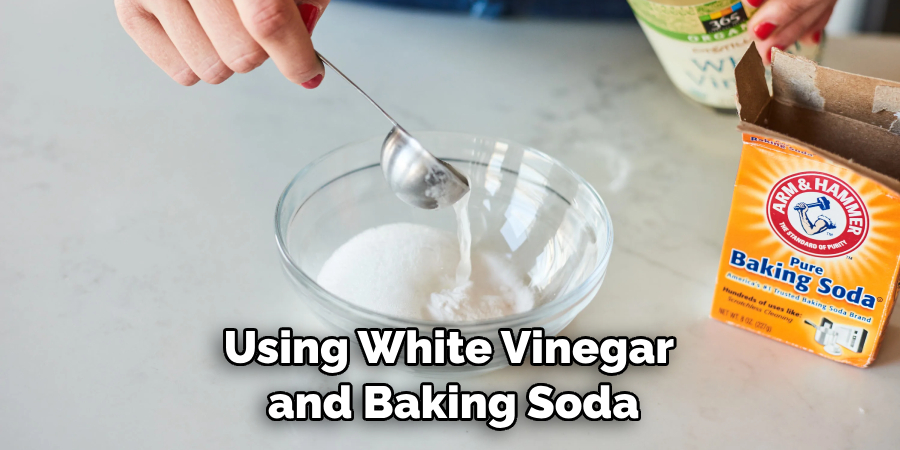
So, if you want to keep your wooden floors and home healthy and odor-free, it’s important to treat dog urine on your wood floors promptly.
How to Treat Dog Urine on Wood Floors: A Comprehensive Guide
1. Assess the Damage
Before treating the urine stain, it’s important to assess the damage. Depending on the length of time that the urine has been on the floor, it could have seeped deep into the wood, leaving a highly noticeable stain. If the urine is relatively new, however, you may be able to remove it with just a few common household items. Regardless, identifying the extent of the damage will help you determine the best course of action.
2. Clean the Stain
Mix equal parts water and white vinegar in a spray bottle to clean the urine stain. Liberally spray the affected area, soaking the wood and the surrounding area. After five minutes, wipe the area with a clean rag. If the stain persists, repeat the process until the urine is fully removed. Note that you should avoid using ammonia-based cleaners, as they can actually worsen the odor and cause further damage to the wood.
3. Remove the Smell
Even after the urine has been removed, it’s common for a lingering odor to persist. To get rid of the smell, mix one part hydrogen peroxide with one part water in a spray bottle. Spray the mixture onto the affected area and let it sit for a few minutes. Afterward, wipe the area with a clean rag. This will help neutralize the odor and prevent your dog from returning to the same spot.
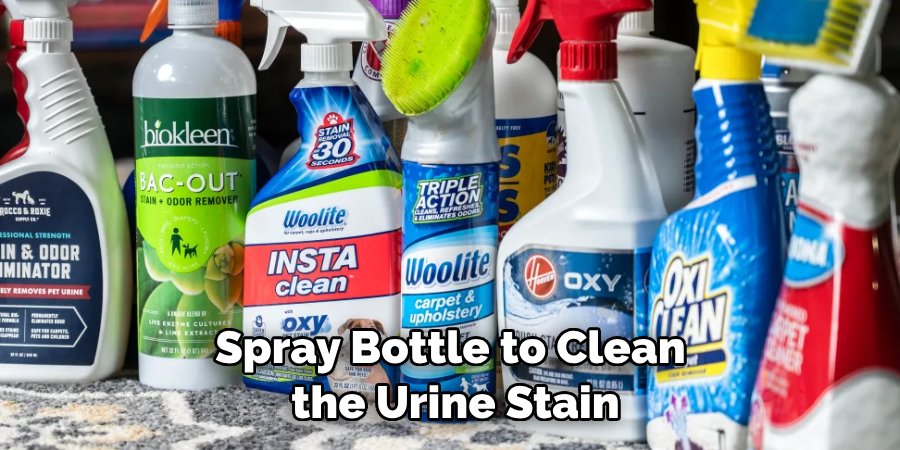
4. Sand the Stain
If the urine stain has been sitting on the wood floor for an extended period, it may have seeped deep into the wood. In this case, simply cleaning the surface of the wood won’t be enough to fully remove the stain. In these instances, sanding the affected area may be necessary. Use fine-grit sandpaper and lightly rub the area in a circular motion until the stain disappears. Keep in mind, however, that sanding too deeply can cause permanent damage to your flooring.
5. Apply Wood Stain
Once the urine stain has been removed, you may need to apply a wood stain to even out the color of the flooring. To do this, select a shade of wood stain that closely matches your current flooring and gently apply it to the affected area using a clean rag. Allow the stain to dry completely before applying a second coat, if necessary.
6. Seal the Wood
To protect the wood from further damage, it’s important to seal the affected area after the stain has been applied. To do this, apply a clear water-based polyurethane to the flooring and allow it to dry completely before walking. This will help prevent dirt or grime from penetrating the wood and causing further damage.
7. Train Your Dog
The best way to prevent urine stains on your wooden floors is to train your dog not to urinate indoors. This can be done by regularly taking your dog for walks, providing them with plenty of toys and exercise, and establishing a spot in the yard where they can go potty. With some patience and dedication, you can train your dog to use the restroom outdoors and avoid future messes!
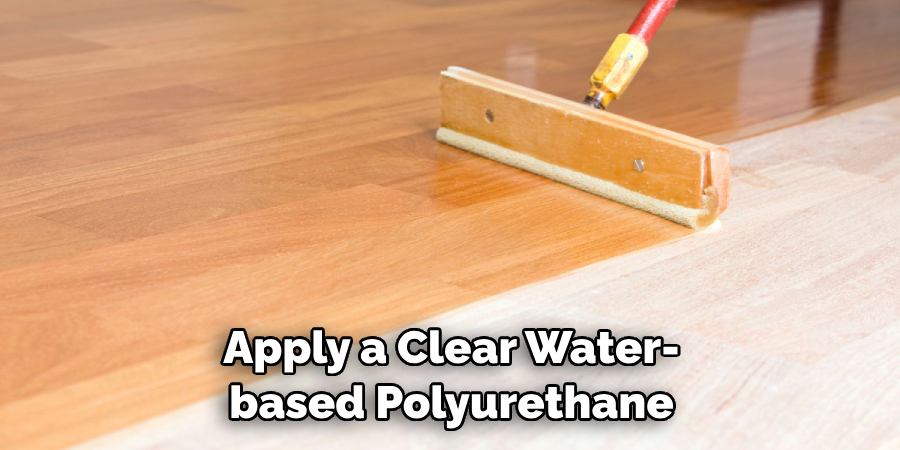
With these tips in mind, you’ll be able to successfully treat any urine stains on your wood floors and prevent further damage. Remember – it’s important to act quickly when treating pet accidents, as the longer the urine sits, the worse the damage will be. So keep these tips in mind, and you’ll be able to keep your wooden floors looking good as new in no time!
5 Considerations Things When You Need to Treat Dog Urine on Wood Floors
1. Clean the Area
The first step in treating dog urine on wood floors is to clean the affected area. Use a cleaning solution specifically designed for wood floors, and scrub the area with a soft-bristled brush thoroughly. This will help to remove any residual urine as well as any dirt or debris that may have become embedded in the wood. After cleaning, dry the area completely using a clean cloth or mop.
2. Remove Odor
Once the area has been cleaned, it’s important to remove any lingering odors from the dog’s urine. Several products are available on the market specifically designed for this purpose, such as enzymatic cleaners and odor neutralizers. These products break down the molecules in pet urine that cause odors, leaving behind a fresh scent instead.
3. Seal the Wood
To prevent future damage, it’s important to seal the wood after it has been cleaned and treated for odor removal. This can be done by applying a sealant such as polyurethane or varnish to protect against moisture and wear and tear. Be sure to apply multiple coats of sealant to ensure maximum protection against future accidents.
4. Consider Carpeting
If your wood floor is badly damaged due to dog urine, you may want to consider covering it with carpeting instead of repairing it or replacing it altogether. Carpeting can provide an added layer of protection while helping absorb odors and keep your home smelling fresh and clean all year round.
5. Regular Maintenance
Regular maintenance and cleaning routines are the best way to prevent damage from pet urine on wood floors. Make sure you vacuum regularly and use a damp mop when needed to remove dirt, dust, and other debris that can accumulate over time on your flooring surface. Additionally, immediately check for signs of pet accidents so they can be dealt with quickly before they cause further damage or staining.

Benefits of Treat Dog Urine on Wood Floors
If you’re lucky enough to share your home with a furry friend, you know that having a dog has its ups and downs. While they bring immense joy and unconditional love into our lives, they also come with their fair share of messes. And when it comes to hardwood floors, dog urine can be especially damaging if not treated promptly and properly.
But fear not! There are many benefits to treating dog urine on your hardwood floors, such as preventing staining and reducing odor. Moreover, timely treatment can prevent permanent damage to your flooring and save you from costly repairs. So, whether you’re a seasoned dog owner or a new pup parent, be proactive and take the necessary steps to ensure that your precious hardwood floors remain pristine and beautiful for many years.
Conclusion
While dog urine on your wooden floors may be frustrating, it doesn’t have to result in permanent damage or a permanent odor. By assessing the damage, cleaning the area, removing potential smells, sanding if necessary, and applying a protective sealant, you can eliminate the problem and prevent future incidents.
So, next time your furry friend has an accident, know that with the right steps, your wood floors will be good as new. Thanks for reading our post about how to treat dog urine on wood floors.

